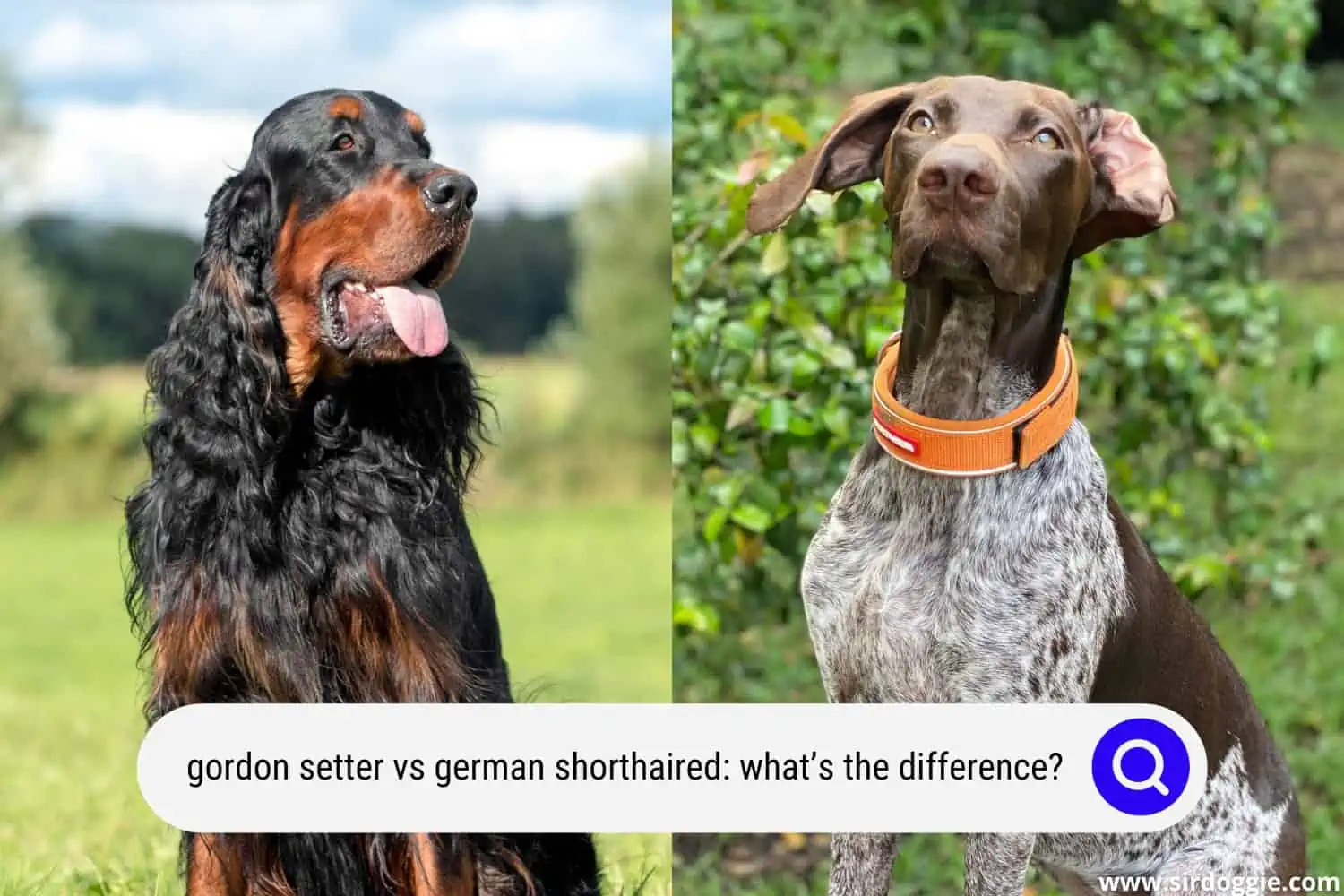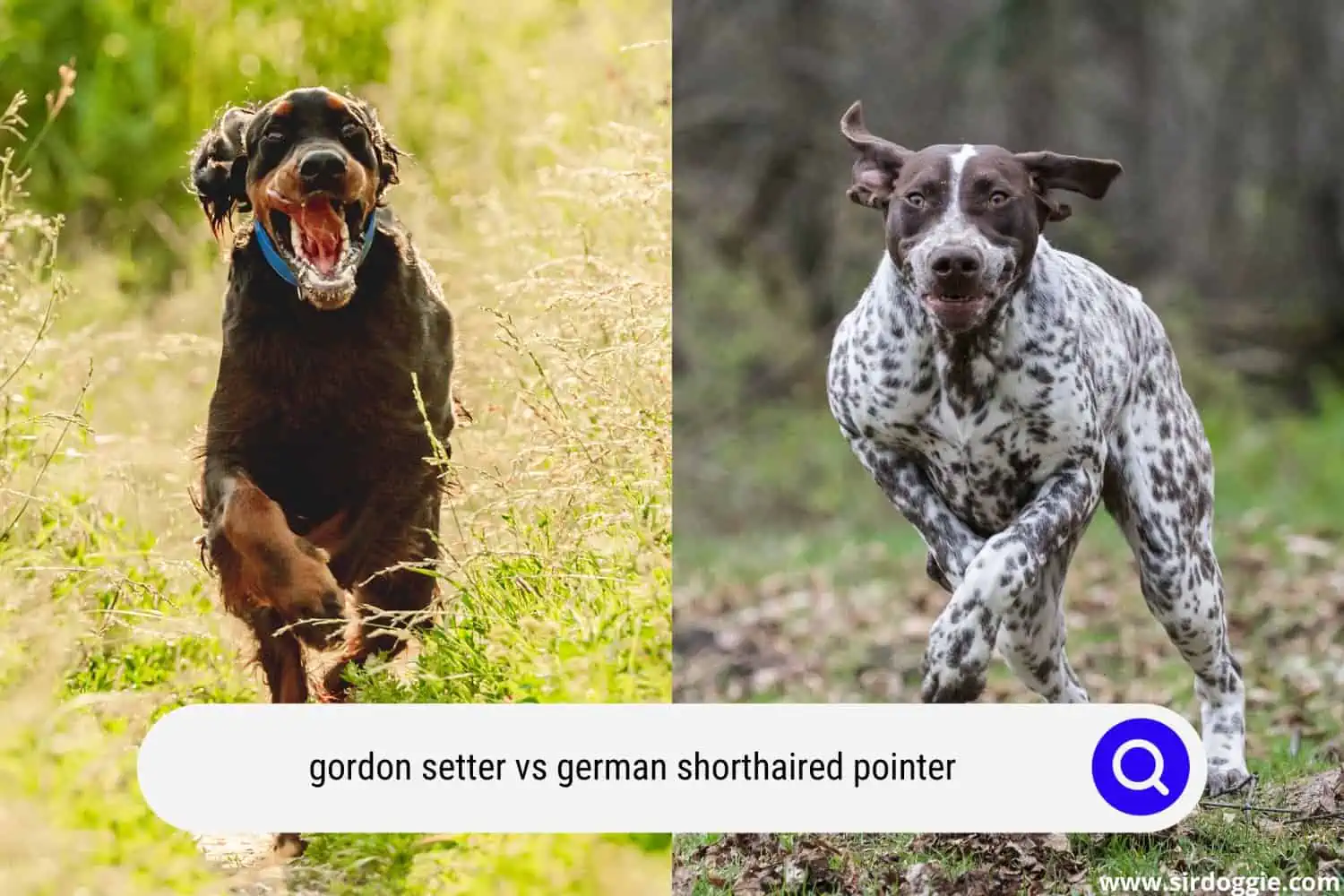Gordon Setter vs German Shorthaired Pointer: What’s the Difference?
The Gordon setter is the strongest of the four breeds of setters, and as far as one can say about the setter, the toughest and sharpest. Meanwhile, the German Shorthaired Pointer is a people-related dog that does not like to be alone for long without occupation.

Coming from different categories of dogs – pointers and setters – the Gordon Setter and the GSP are two different dog breeds, physically, character-wise, and health-wise.
But which one will be suitable for you – the Scotland-originated Gordon Setter or the short-haired pointer from Germany? In this Gordon Setter vs German Shorthaired Pointer article, we will see analyses of both breeds and side-by-side comparisons.
The Gordon Setter
The Gordon Setter is still used today as a hunting dog. However, it is by no means only to be used as a pure pointing dog. It has also proven itself on the trails and in waterworks.
Gordon Setter: Origin and history
The Gordon Setter originated from Scotland. It’s most likely named after Gordon, a village in Scotland, or a former Duke of the village.
In the late 18th century, the Duke of Gordon reportedly owned a famous black and red setter, which was characterized by particularly intelligent, heavy dogs. For the work in the difficult terrain of Scotland, the fast, elegant dog was less required than the persistent, powerful dog.
The Gordon Setter used to have white markings, which are now limited to a small patch around the chest. According to the Duke of Gordon’s reports, a working Collie was crossed to make an intelligent and obedient Gordon Setter.
The Gordon Setter is said to have been hunting game birds for more than 200 years.
Gordon Setter: Physical appearance
The Gordon Setter has a deep black color with a deep chestnut-colored burn. A small white mark on the chest is allowed. It has a set of long ears.
There are also pure beauty breeds because the Gordon Setter has always delighted dog lovers with its shiny black-red coat, its smooth movements, and its pleasant nature. As with the three other setter breeds, you have to think carefully about your purchase.
A Gordon – if its talents are well developed – is not a dog for everyone. It is by no means suitable as a status symbol that should only attract admiring glances at itself and its owner.
This dog needs to run and work to be happy and balanced. If it cannot do that, it becomes a burden for everyone involved.
Gordon Setter: Temperament, activities, and care
The Gordon Setter is a one-man dog that prefers to hunt alone with its master.
It is rather reserved towards strangers and does not tolerate changes of ownership. The Gordon Setter matures late and needs a consistent upbringing from an early age.
Setters are self-confident dogs with a great passion for hunting, whose training must be carried out consistently.
For the hunter, it is ideal as a pointing dog for field work and shows a special talent in hunting for hoofed games. It is also very water-loving.
When deployed as a family dog, it needs just as consistent upbringing with meaningful activities like hunting dogs to be able to curb its hunting passion. Daily grooming is necessary.
If you are interested in a Gordon Setter as a family and companion dog, choose a dog from a beauty breed. Otherwise, you could have problems with the strong hunting instinct.
Make it join an agility group, and go biking with it. Obedience is also a good setter training.
All setter breeds are sensitive stubborn heads. Upbringing requires a good dose of sensitivity, but also consistency. They are not dogs for beginners.
Also, some setters can be very sensitive, always on the ball. This is a little too strenuous for many people. Think carefully before you bring one of these beautiful but also demanding dogs into your home.
Setters can react very sensitively to changes in food. They are also relatively prone to tumors. After castration or neutering, both bitches and males develop an unsightly, woolly coat.
Some become lazy and they tend to become fat. Bitches often become incontinent. For this reason, this procedure should only be performed on the setter if there is an important medical indication.
The German Shorthaired Pointer
The German Shorthaired Pointer, also called Kurzhaars or simply GSP, is a dog with a lot of energy. It requires at least an hour of exercise each day, preferably without a leash. Without enough exercise, your German Shorthaired Pointer can become nervous and destructive.
German Shorthaired Pointer: Origin and history
This dog dates back to the seventeenth century, but the German Shorthaired Pointer known today was bred to be a versatile hunting dog in the nineteenth century.
Hunters chose dogs with docile personalities but increasingly wanted elegance and style with powerful sensing talent. They made use of England-imported pointers, adding style and creating a breed that works on land and in water.
Prince Solms-Braunfeld from the Hanoverian royal family wrote to encourage breeders to select early specimens based on function instead of appearance. It resulted in a slim, sporty, and approachable “all-round hunting dog” that is also a smart and loving companion.
In 1925, one of the first German Shorthaired Pointers was imported into the USA by Dr. Thornton from Montana who started to breed the GSPs. However, five years later, the AKC recognized the breed.
The 2nd World War influenced how German Shorthaired Pointers were bred. When the war almost came to an end, a lot of breeders kept their golds, diamonds, artwork, stallions, and also their GSP dogs.
The best breeds were sent for safekeeping to Yugoslavia. However, as Yugoslavia was among the so-called Iron Curtain since the end of World War II, the West German breeders had no access to these pointers and had to make the breed out of a gene pool that was limited
German Shorthaired Pointer: Physical appearance
The Kurzhaar has short, thick, water-resistant fur that is slightly longer on the underside of the tail and the edges of the rear part, called clubs. On the head, the hair is softer, thinner, and shorter.
The distinctive fur is a chocolate brown or white and chocolate brown combination. They may be ticked (having areas of small isolated black fur on a white background), speckled, or reddish-gray (a fine mix of colored hair with white hair). For example, a chocolate-brown-reddish-gray GSP has a deep reddish-brown fur, which is lightened by white hair.
The German shorthaired pointer’s soft, short coat is easy to groom and does not shave a lot. Brush it weekly with a stiff bristle brush and bathe it only as needed. Rub off the dog’s fur with a towel or chamois to make it shine.
German Shorthaired Pointer: Temperament
The German shorthaired pointer is friendly, clever, and willing, as well as always trying hard in everything without fluttering or feeling nervous. However, it does not like to be alone and can have separation anxiety. It is a home dog and it’s not a kennel or yard dog. It likes every family member but may have a favorite. The dog is very easy to train.
Like any dog, the Kurzhaar needs early socialization – it should get to know different people when it is young. Socialization ensures your German-shorthaired pointer puppy will grow into a mature dog.
Enroll it in a training class, invite plenty of regular visitors, take the dog to dog-friendly shops and crowded parks, and walk it down the streets.
GSPs are prone to hip dysplasia, elbow dysplasia, entropion, lymphedema, hypothyroidism, and von Willebrand syndrome.
Gordon Setter vs German shorthaired pointer: a side-by-side comparison
| German shorthaired pointer | Gordon Setter | |
| other names | Kurzhaar, GSP | Black setter, Scottish setter |
| Origin | Germany | Great Britain, Scotland |
| Size | Large breeds of dogs | Large breeds of dogs |
| Type | Sporty dog breeds, child-friendly dog breeds | Sporty dog breeds, child-friendly dog breeds |
| Life expectancy | 12-14 years | 10-15 years |
| Temperament / activity | Affectionate, intelligent, educable, exuberant, bold, cooperative | Loyal, confident, attentive, fearless, eager |
| Height at withers | Bitch: 58–63 cm. Males: 62–66 cm | Bitch: 61–63 cm. Males: 65–67 cm. |
| Weight | Bitch: 20.4–27.2 kg. Males: 24.9–31.8 kg | Bitch: 25–31.8 kg. Males: 29–36.4 kg |
| Coat colors | Liver, brown, black and white, brown and white, liver and white, liver reddish gray | Black and tan |
| Hypoallergenic | No | Kurzhaar |

Conclusion
The GSP is not suitable for residential life. They are more suitable for active people who have a house with a large garden and a high fence.
The GSP was bred to have a lot of stamina and energy that can be used all day in the field, so exercise is very important to them. Without enough exercise, they can become nervous and destructive. They need at least one hour of exercise every day.
Meanwhile, the Gordon Setter is also a large breed of dog that is sporty and child-friendly. They can reach 15 years of age. These dogs are loyal, attentive, fearless, and confident. They are great for hunting and field trials. They’re also terrific as a companion in a family home.

Family Dog Expert Author
Hi there! I’m Stuart, a devoted dog lover and family dog expert with over a decade of experience working with our furry companions. My passion for dogs drives me to share my knowledge and expertise, helping families build strong, loving bonds with their four-legged friends. When I’m not writing for SirDoggie, you’ll find me hiking, playing with my beautiful dog, or studying music.